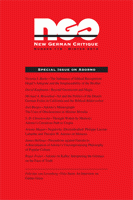Rosenthal, Michael A. “Art and Politics of the Desert: German Exiles in California and the Biblical Bilderverbot.” New German Critique 118.40.1 (2013), 43-64.
In the early 1940s, while he lived in exile in Los Angeles, Thomas Mann wrote a novella called The Tables of the Law (Das Gesetz). Mann was not the only exile to focus on the theme of receiving the commandments at Sinai. Before he left Germany, Arnold Schoenberg had composed the first two acts of the opera Moses und Aron, and he worked on the third act during his time in Los Angeles. For both men, the Second Commandment, against idolatry (the Bilderverbot), played an important role. Theodor W. Adorno believed that the prohibition against images was the key to understanding Schoenberg's approach to music itself. But it was more than a purely aesthetic issue. Each of these intellectuals claims that the Bilderverbot was central to the contemporary political struggles. In Adorno's mind, not only had the Nazis violated the ban against graven images, but Hollywood's “culture industry” was guilty of the same crime. The industrial production of images was designed to pacify and control the masses. For both Mann and Schoenberg, a return to the Bible through modernist aesthetics could help recuperate myth from its misuse and thus restore a healthy polity.
